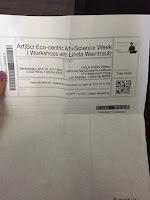Event 1
 The first event I went to this quarter was a hands on workshop with Linda Weintraub where she showed a small group of us her exhibition at UCLA. Before we even went into the exhibition, Linda gave us some insightful information that relates to the class materials. A significant aspect of the exhibition was putting away your manufactured materials, like your phones and interacting with nature, which relates to an idea that Linda talked about called Neo-materialism. In his book, Neo-Materialism, Joshua Simon looks at the notion of neo-materialism as questioning the “material, shape, volume, scale, composition, and authorship only through the commodity character of objects” (Simon).
The first event I went to this quarter was a hands on workshop with Linda Weintraub where she showed a small group of us her exhibition at UCLA. Before we even went into the exhibition, Linda gave us some insightful information that relates to the class materials. A significant aspect of the exhibition was putting away your manufactured materials, like your phones and interacting with nature, which relates to an idea that Linda talked about called Neo-materialism. In his book, Neo-Materialism, Joshua Simon looks at the notion of neo-materialism as questioning the “material, shape, volume, scale, composition, and authorship only through the commodity character of objects” (Simon).  |
| Selfie |
This idea of neo-materialism relates a lot to week 2’s unit and the idea of math and art coming together. The art aspect of neo-materialism that I saw in the exhibition is found through the creative aspect of us interacting with the materials through our senses. The math in this exhibition comes from the neo-materialist idea of shape and volume when I was asked to feel the different textures of many pinecones and order the pinecone heads in size order. These activates used a basic understanding of math like counting and measurement and was an important aspect of this exhibition. (Lecture 2)
After talking to Linda, I found it amazing that she grows everything in her backyard in upstate New York. In an interview with Linda written in Roll Magazine, the writer talks about how Linda is very much concerned with nature and how we today are causing global warning because we depend so much on man-made materials. In a study shown by the LA Times, that 92% of teens go online daily showing how much people rely on materials, like technology, every day to survive (Pierson). I find it very empowering that she acts to change global warning because around 60-70% of Americans know global warning is happening, but they do not believe it will harm them personally so they do not do anything to help it. (NY Times).
 |
| https://www.nytimes.com/interactive/2017/03/21/climate/how-americans-think-about-climate-change-in-six-maps.html?_r=0 |
References
David, Pierson. "Most Teens Rely on Smartphones to Go Online, Study Finds." Los Angeles Times. Los Angeles Times, 9 Apr. 2015. Web. 23 Apr. 2017. <http://www.latimes.com/business/technology/la-fi-tn-teen-tech-20150409-story.html>.
L Lambe, Claire. "An Interview with Linda Weintraub – Curator of "Dear Mother Nature: Hudson Valley Artists 2012" at The Dorsky." Roll Online. N.p., n.d. Web. 23 Apr. 2017. <http://www.rollmagazine.com/an-interview-with-linda-weintraub-%E2%80%93-curator-of-%E2%80%9Cdear-mother-nature-hudson-valley-artists-2012%E2%80%9D-at-the-dorsky/>.
P Popovich, Nadja, John Schwartz, and Tatiana Schlossberg. "How Americans Think About Climate Change, in Six Maps." The New York Times. The New York Times, 21 Mar. 2017. Web. 23 Apr. 2017. <https://www.nytimes.com/interactive/2017/03/21/climate/how-americans-think-about-climate-change-in-six-maps.html?_r=0>.
Simon, Joshua. "Neo-Materialism, Part I: The Commodity and the Exhibition." Neo-Materialism, Part I: The Commodity and the Exhibition - Journal #20 November 2010 - E-flux. E-flux, Nov. 2010. Web. 23 Apr. 2017. <http://www.e-flux.com/journal/20/67643/neo-materialism-part-i-the-commodity-and-the-exhibition/>.
Versa, Victoria. “Mathematics.” Lecture. CoLE DESMA 9. Web.


Comments
Post a Comment